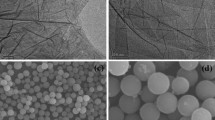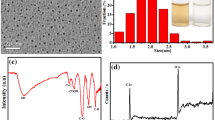Abstract
The tribological properties of graphene oxide (GO) nanosheets and modified diamond (MD) nanoparticles with excellent water-solubility were investigated. GO nanosheets were synthesized using carbon fibers with a regular and uniform size, the lateral size being around 30 nm and the thickness being 2 or 3 nm, while MD nanoparticles were about 30 nm in the three dimensions. The friction properties of ceramics were improved by GO nanosheets or MD nanoparticles used as additives in water-based lubrication, though the effects of two nanoparticles were quite different. For GO nanosheets, the friction coefficient at the beginning decreased sharply from 0.6 to 0.1, as compared with the dionized water lubrication. At the same time, the running-in period was shortened from 2000 s to 250 s. A steady state characterized by ultralow friction (friction coefficient=0.01) was obtained after the running-in period. In the case of MD nanoparticles, the friction coefficient stayed at 0.1 without further decrease during the whole experiment. Based on the observation of wear scar and characterization of remains on the wear track, the positive effect of GO nanosheets was attributed to their lamellar structure and geometric size. MD nanoparticles reduced friction by forming the regularly grained surface on the mating surfaces, and prevented further reduction in steady-state friction coefficient owing to their larger size and hardness. In conclusion, GO nanosheets exhibited favorable potential as an effective additive for water-based lubrication.
Similar content being viewed by others
References
Balazs A C, Emrick T. Nanoparticle polymer composites: Where two small worlds meet. Science, 2006, 314(17): 1107–1110
Yu C, Kim Y S, Kim D, et al. Thermoelectric behavior of segregated-network polymer nanocomposites. Nano Lett, 2008, 8(12): 4428–4432
Prasher R, Bhattacharya P, Phelan P. Thermal conductivity of nanoscale colloidal solutions (nanofluids). Phys Rev Lett, 2005, 94: 025901
Li W, Zheng S H, Cao B Q, et al. Friction and wear properties of ZrO2/SiO2 composite nanoparticles. J Nanopart Res, 2010, 13(5): 2129–2137
Bakunin V N, Suslov A Y, Kuzmina G N. Synthesis and application of inorganic nanoparticles as lubricant components — A review. J Nanopart Res, 2004, 6(2-3): 273–284
Lee K, Hwang Y, Cheong S, et al. Understanding the role of nanoparticles in nano-oil lubrication. Tribol Lett, 2009, 35(2): 127–131
Lee K, Hwang Y, Cheong S, et al. Performance evaluation of nano-lubricants of fullerene nanoparticles in refrigeration mineral oil. Current Appl Phys, 2009, 9(2): e128–e131
Yu H L, Xu Y, Shi P J, et al. Tribological behaviors of surface-coated serpentine ultrafine powders as lubricant additive. Tribol Int, 2010, 43(3): 667–675
Qi X W, Jia Z N, Yang Y L, et al. Characterization and auto-restoration mechanism of nanoscale serpentine powder as lubricating oil additive under high temperature. Tribol Int, 2011, 44(7–8): 805–810
Bandyopadhyaya R, Kumar R. Modelling of CaCO3 nanoparticle formation during overbasing of lubricating oil additives. Langmuir, 2001, 17(4): 1015–1029
Ji X B, Chen Y, Zhao G Q, et al. Tribological Properties of CaCO3 nanoparticles as an additive in lithium grease. Tribol Lett, 2010, 41(1): 113–119
Huang H D, Tu J P, Gan L P, et al. An investigation on tribological properties of graphite nanosheets as oil additive. Wear, 2006, 261(2): 140–144
Rosentsveig R, Gorodnev A, Feuerstein N, et al. Fullerene-like MoS2 nanoparticles and their tribological behavior. Tribol Lett, 2009, 36(2): 175–182
Hu K H, Liu M, Wang Q J, et al. Tribological properties of molybdenum disulfide nanosheets by monolayer restacking process as additive in liquid paraffin. Tribol Int, 2009, 42(1): 33–39
Kolodziejczyk L, Martínez-Martínez D, Rojas T C, et al. Surface-modified Pd nanoparticles as a superior additive for lubrication. J Nanopart Res, 2006, 9(4): 639–645
Sánchez-López J C, Abad M D, Kolodziejczyk L, et al. Surface-modified Pd and Au nanoparticles for anti-wear applications. Tribol Int, 2011, 44(6): 720–726
Tarasov S, Kolubaev A, Belyaev S, et al. Study of friction reduction by nanocopper additives to motor oil. Wear, 2002, 252(1–2): 63–69
Kang X, Wang B, Zhu L, et al. Synthesis and tribological property study of oleic acid-modified copper sulfide nanoparticles. Wear, 2008, 265(1–2): 150–154
Sulek M W, Wasilewski T. Antiseizure properties of aqueous solutions of compounds forming liquid crystalline structures. Tribol Lett, 2005, 18(2): 197–205
Sulek M W, Wasilewski T, KurzydŁowski K J. The effect of concentration on lubricating properties of aqueous solutions of sodium lauryl sulfate and ethoxylated sodium lauryl sulfate. Tribol Lett, 2010, 40(3): 337–345
Tomala A, Karpinska A, Werner W S M, et al. Tribological properties of additives for water-based lubricants. Wear, 2010, 269(11–12): 804–810
Zhang C H, Zhao Y C, Björling M, et al. EHL properties of polyalkylene glycols and their aqueous solutions. Tribol Lett, 2011, 45(3): 379–385
Novoselov K S, Geim A K, Morozov S V, et al. Electric field effect in atomically thin carbon film. Science, 2004, 306(5696): 666–669
Lee C, Wei X D, Kysar J W, et al. Measurement of the elastic properties and intrinsic strength of monolayer graphene. Science, 2008, 321(5887): 385–388
Ou J F, Wang J Q, Liu S, et al. Tribology study of reduced graphene oxide sheets on silicon substrate synthesized via covalent assembly. Langmuir, 2010, 26(20): 15830–15836
Pu J B, Wan S H, Zhao W J, et al. Preparation and Tribological study of functionalized graphene-IL nanocomposite ultrathin lubrication films on Si substrates. J Phys Chem C, 2011, 115(27): 13275–13284
Ou J F, Wang Y, Wang J Q, et al. Self-assembly of octadecyltrichlorosilane on graphene oxide and the tribological performances of the resultant film. J Phys Chem C, 2011, 115(20): 10080–10086
Liu S, Ou J F, Li Z P, et al. Layer-by-layer assembly and tribological property of multilayer ultrathin films constructed by modified graphene sheets and polyethyleneimine. Appl Surf Sci, 2012, 258(7): 2231–2236
Luo J Y, Cote L J, Tung V C, et al. Graphene oxide nanocolloids. J Am Chem Soc, 2010, 132(50): 17667–17669
Hummers W S, Offeman R E. Preparation of graphitic oxide. J Amer Chem, 1958, 80(6): 1339–1339
Kim F, Luo J Y, Cruz-Silva R, et al. Self-propagating domino-like reactions in oxidized graphite. Adv Funct Mater, 2010, 20(17): 2867–2873
Tomizawa H, Fischer T E. Friction and wear of silicon nitride and silicon carbide in water: Hydrodynamic lubrication at low sliding speed obtained by tribochemical wear. ASLE Trans, 1987, 30(1): 41–46
Xu J G, Kato K. Formation of tribochemical layer of ceramics sliding in water and its role for low friction. Wear, 2000, 245(1–2): 61–75
Jahanmir S, Ozmen Y, Ives L K. Water lubrication of silicon nitride in sliding. Tribol Lett, 2004, 17(3): 409–417
Gates R S, Hsu S M. Tribochemistry between water and Si3N4 and SiC: Induction time analysis. Tribol Lett, 2004, 17(3): 399–407
Author information
Authors and Affiliations
Corresponding author
Additional information
These two authors contribute equally to this paper
Rights and permissions
About this article
Cite this article
Liu, Y., Wang, X., Pan, G. et al. A comparative study between graphene oxide and diamond nanoparticles as water-based lubricating additives. Sci. China Technol. Sci. 56, 152–157 (2013). https://doi.org/10.1007/s11431-012-5026-z
Received:
Accepted:
Published:
Issue Date:
DOI: https://doi.org/10.1007/s11431-012-5026-z




